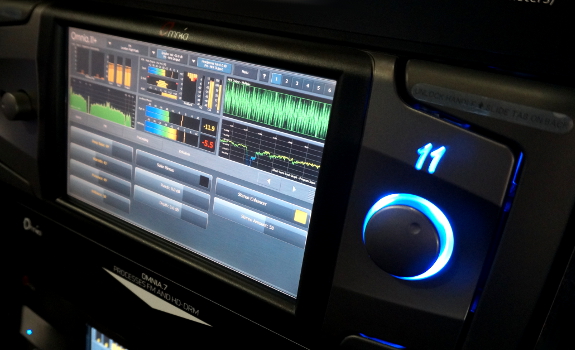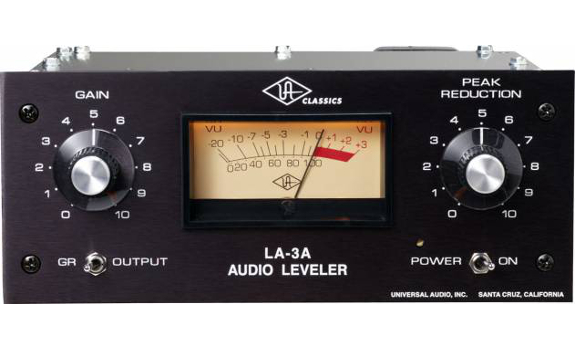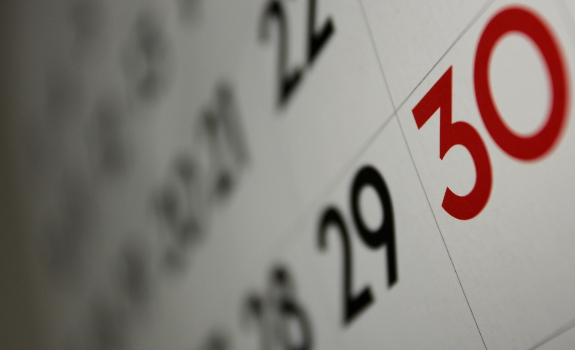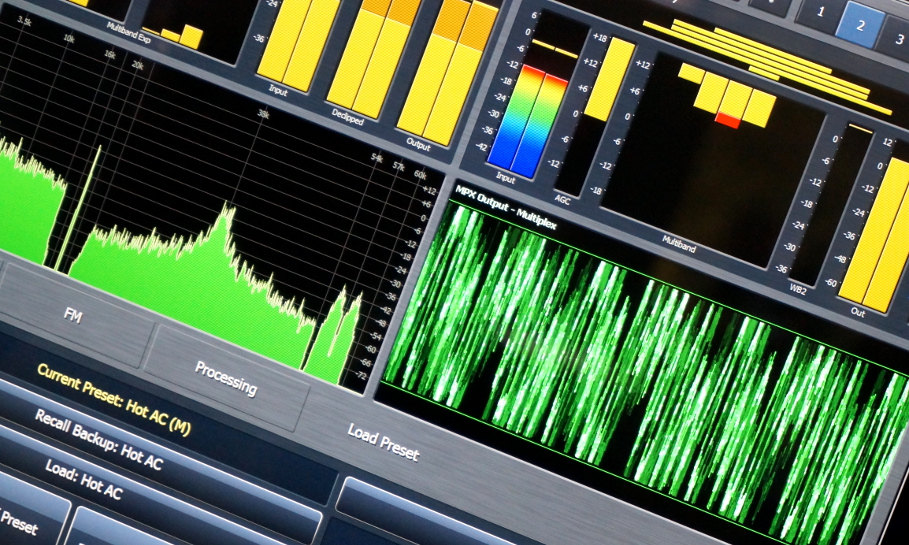What happens inside the ‘black box’, and how to maximise its effect? Audio processing explained, from the very basics to best practices, in an interview with Omnia’s Frank Foti.
Audio processing seems to be a topic that’s very much for tech guys, but as a jock hosting your radio show or as a PD tweaking your station sound, you may want to understand the essence of audio processing yourself. Omnia-founder (and first chief engineer of Z100) Frank Foti was kind enough to share some ideas on creating a great on-air sound. “It just jumps out of the speakers! That’s what you’re looking for.”
“Don’t go heavy on it”

Instead of radical changes in audio processing setups, gradually adjusting (one element of) your station’s on air sound at a time could be a better approach (image: Thomas Giger)
Make your station recognisable
Starting with the very basics, Foti explains that audio processing consists of 2 main components. One of them is a device that will make sure that overmodulation (too much level into the transmitter) does not occur. In the US, the FCC specified that the audio level for FM transmitters cannot exceed a carrier deviation of 75 kHz per second, something that American radio often refers to as ‘100% modulation’. For AM, there are different rules: “For medium wave broadcasting, we have to do precision peak control, so that the peak level never exceeds more than twice the amplitude of the carrier.” Apart from this technical need, audio processing is obviously used in more passionate way to create a consistent signature sound, from applying equalisation to dynamically controlling audio levels with automatic gain control, compression and limiting (such as peak limiting, and hard limiting or clipping).“There’s no perfect recipe in how to achieve all of these”, he says. “In each of those functions, there’s a whole host of other aspects that play host to it. Attack, release, ratio, threshold, gating… the list goes on an on. Within all of these, we can talk about, for example, how the attack and the release properties are created; there’s multiple ways of doing that.”
Find your loudness/quality balance
In his radio engineering days, he’s heard one request more than any other. “Every broadcaster’s dream is to be as loud as possible. It does not matter if they’re playing Hard Rock or Classical music, I’ve never met a broadcaster yet who’s never once said: how can we be a little bit louder?” He explains there are different characteristics to audio processing that will affect loudness and audio quality trade-off, based on how a processor’s 3 main stages (gain control or compression, limiting, and then hard limiting or clipping) work together. “Generally, if you push the limiting or the clipping, you get louder, but you start to hear the effect of it. Look for a sweet spot where there’s a nice, full, rich sound that’s competitively loud, and you’re getting the best of both worlds.”
Define your main goal
Frank Foti’s recommendation for radio programmers, managers & owners who want to adjust their audio processing outside of factory presets is to have a clear goal, but make small refinements. “Take a little bit of time to understand how to drive or operate the device, so you can say: okay, we want it to be a bit fatter sounding, so it looks like we need to push the multi-band limiters a little bit. Or: we want a bit more overall loudness, so if the clipping is now set for half a dB of clipping, let’s see what happens if we increase it by half a dB. Someone might say: half a dB is just a small amount of signal. Well, it is, if we’re talking about unprocessed audio — but audio that’s been processed is fairly dense. If we raise that by half a dB, the effect to the ear is audible.” Therefore, his advice is to work on one thing at a time, and make only small adjustments. “Don’t go heavy on it. Take a listen for a while, and see if that’s the effect you’re looking for.”
“Avoid high-frequency distortion”

That, and not high frequencies themselves, is irritating female listeners (image: Flickr / Billy Wilson)
Know your success causes
That’s a very good tip, actually, because many people will feel like changing everything at the same time — because they want more bass, and more treble, and more loudness…
“Right, and in the end, if you like [the end result] or not, you don’t really know which item made the difference. What I’ve always done is listen to something and say: what’s the one item that’s most important? When I got that, I’d say: what’s next? By taking a step-by-step approach, I was usually able to get where I wanted to get. Did that happen in five minutes? Very rarely. Sometimes it might have taken hours or even days, but least I would use a methodical way to get from point A to point B.”
Please your female listeners
Could you go into some basics like: what are the consequences if you, for example, add more loudness, or more treble, or more bass, and provide some general do’s & don’ts?
“If you start adding too much clipping, at some point, things are going to sound broken”, Foti says in reference to general distortion caused by a desire to sound very loud. “Voices will start to sound unnatural, like they’re tearing.” An compelling topic is the apparent female intolerance for treble. In his opinion, you want to avoid high-frequency distortion instead of high frequencies themselves: “I’ve had a discussion with program directors of AC stations who were saying: don’t turn the highs up! I said: why? They would say: women will tune out. I said: no, that’s not true. Female listeners will tune out if they’re hearing high-frequency distortion, like when cymbals aren’t clean anymore, or when the upper keys of a piano sound unnatural.”
Reduce your bass clipping
His advice is to also avoid low-frequency distortion: “If you are overdriving something with low frequencies, it can create the effect of too much clipping when in fact there isn’t too much of it. The wavelength of bass is the biggest within the frequency spectrum, so if a bass note gets into clipping, it’s pushing the entire range of the audio spectrum momentarily into clipping as well. That starts to give a very unnatural sound; almost a broken sound. Most signal processors will give you the option of setting a clip threshold for bass independently of everything else, which will minimise bass-induced intermodulation distortion. If there’s a multi-band limiting section involved, and you have access to its parameters in the form of threshold and attack time, there are ways to tune how low frequencies perform with respect to that deep, rich, punchy bass as compared to overdriven bass tradeoff.”
“Make that microphone shake the pearly gates from heaven”

This device was the secret behind the big & bold jock mic sound on Z100 (image: Attack Magazine)
Please your male listeners
There was a guy in the sixties, James Schulke, who programmed Beautiful Music stations for a female target audience. In an aim for a long Time Spent Listening, he avoided any possible tune-out factors, such as harsh, high-frequency sounds. But what about men? Are they into, or not into, certain sounds?
“Men love loudness, men love bass”, Frank Foti knows. “There’s something in broadcasting called ‘the smile curve’. It’s where you take a 10-band equaliser, and you crank up the low frequencies and high frequencies. When you look at the faders, it looks like a smile. There was a time when a decent stereo system had an equaliser. If it belonged to a man, that’s usually what the curve was.”
Yeah, same with mine! It was like a V-curve.
“Yep. I’m guilty of it myself. I enjoy loud audio. I grew up on The Who. They knew loud! Haha.”
Power your voice processing
Confession: during the first years when I was on the radio, my mic-EQ was always like: a little bit of treble, and of course, lots of bass. And I turned mid frequencies back, to sound like a power jock… Of course, the listener didn’t understand much of what I said, but in the studio, on my headphone, it sounded great, hahaha.
“A fun anecdotal story: in 1983, when we put Z100 on the air, program director Scott Shannon said to me: Franko, the Z-jays have to sound like the voice of God!” He recalls testing many different compressors, including recent models from renown brands, but none of them sounded right on the air. Weeks of experimenting lead to no real improvement. Then something happened. “I had an old UREI LA-3 compressor, which then was probably 20 years old. I figured: what’s the worst that can happen? So I put it in, dialled it at 10 dB compression, set it for an 8:1 ratio, and went home. The next morning, the phone in my apartment rang. Franko? I don’t know what the hell you did. But the voice of gaaaad is on zeeee one hundred. Goodbye! Click.”
Intermodulate your mic signal
When taking a closer look at this suprising compressor, and why it actually caused the Z100 jocks to sound larger than live, Foti discovered its secret. “Its compressor’s algorithm generated a lot of intermod distortion, but dynamic inner mod distortion makes voice sound bigger than life…! Those other compressors were great, and they sounded wonderful on music, but they didn’t create the intermod that gave this voice-of-God-like sound. You take that, some EQ, and some reverb to make that microphone shake the pearly gates from heaven.”
What is ‘intermod’ exactly?
“Basically, automatic gain control. We’re taking an audio signal that will pass through some gain block. To that gain block, we’re introducing a control signal that will either tell the audio to go up or go down. If we run that control signal too fast, it creates intermodulation distortion. So gain control, by its own nature, is actually friendly intermod.” He explains that the LA-3’s control signal created “just enough added stuff” to make a jock sound huge. However, it’s about the right amount: “If too much of it is allowed to exist, that’s when the audio gets that compacted, pressing-on-your-ears, annoying-as-hell kind of sound.”
“Most of the time, it’s a process”

Rather fine-tune your sound over the course of multiple days or weeks (image: Flickr / Dafne Cholet)
Refresh your ears regularly
We already talked a little bit about best practices for audio processing — what to do, and what not to do. What is the number 1 thing when working with audio processing?
“It’s something I call ‘the sleep-on-it method’. It’s easy to start playing and playing and playing, and say: ah, it sounds fabulous! But we don’t realise that our ears become desensitised over time.” He compares it to putting a finger under a stream of hot water from a kitchen faucet. It first feels really hot, like you’re about to burn, yet after a few seconds, it will begin to feel less hot already. “The same thing happens with our ears. When I’m working on an algorithm, I’ll work on it for no more than 20 minutes. Then I stop, and let my ears decompress or refresh. I’ll go answer some emails, or get a glass of ice tea, which is a drink that I enjoy.”
Take your time evaluating
Frank Foti basically does the same when adjusting a station’s on-air sound. “I’ll work on it for a while, and at some point say: ah, it sounds pretty good. Then I’ll go home. After restarting the process in the morning, I’ll often say: what the hell was I thinking?” In his experience, this takes a couple of days. “When I get to the point of liking it as much as on the day before, that’s when I stop. When setting up signal processing, there’s often a desire to get it done. Let’s go to the transmitter, hook it up, and by midnight we’ll have it! Sometimes it does happen. But most of the time, it’s a process worth investing a few days or even a week into. When you get it right, you can set it, forget it, and move on.”
Monitor your cross-platform sound
When adjusting and fine-tuning audio processing, you probably not only listen on a headset connected to the processor output, but on several devices. How do you create a processing setup that sounds great on any device? Is that a matter of making compromises?
“Some of it comes down to having the right device in the first place. In my office, I have a good set of Tannoy speakers that I use. I also have a low-power FM transmitter so I can listen in my car, or on a couple of table radios. I’m sure the word ‘compromise’ does have to come in somewhere, but from the feedback we’ve been receiving based on our work of recent years, I don’t know of too many compromises. That said, sometimes that is based on people who have taken the time to see to it that it does behave properly on different platforms. By the same token, I have been in cities where I turn the radio on, and I’m like: what the hell is that? And then I come to find that it’s our own product. You can have the nicest airplane; I’ve you’ve got the wrong guy flying it, it may not be flying like the nicest airplane, haha. It does come down to understanding the device, knowing which limitations there are, and doing your best to be the best.”
“There never have been any secret Frank Foti presets”

A radio station’s on-air sound should be tailored to its individual market situation (image: NAB)
Maintain your competitive position
Is it important to monitor what the competition is doing at any point, or should you just focus on your own station and follow your own imagination of how to sound great, even if you’re maybe 2 dB less loud than your neighbour?
“In my days in radio, I was always listening to my station and whoever the competition was. I scanned the dial constantly”, Foti recalls from his time at iconic stations such as The Buzzard and The Flamethrower (as Z100 was nicknamed back then). “When you drive in your car, your eyes are on the front of the road, but every so many seconds you have to look in your rear view mirror with the hope that no-one is going to run into you, or trying to pass you in a way you don’t want them to. We do the same thing.” He also likes European radio. “I love the energy and competitive spirit that I’ve picked up whenever I’ve been in the Netherlands, France, Italy… they just get so passionate about it. It reminds me of when I worked at Z100 in New York or at WMMS here in Cleveland.”
Motivate your on-air team
How do listeners respond to changes in audio processing? Is that measurable?
“If a listener doesn’t like what he’s hearing, he’ll tune out. I don’t expect a listener’s to call and say: ‘you sounded better yesterday’ or ‘you’re sounding louder now’, asking ‘what did you do?’. Processing has always been a very subliminal thing. If you get it right, it is an intangible thing to hold or reinforce your audience. One of the nicest comments I’ve received in New York was: ‘you’ll know when you scan the dial and hit 100.3, because it just jumps out of the speakers!’. That’s what you’re looking for. People didn’t know that there was this bunch of boxes in a rack that were carefully tuned. They don’t care. But that they felt it was a larger-than-life thing was a reinforcement of the disc jockeys and programming people that Z100 had this ‘flamethrower sound’. It might helped to give them the magic to do what they did — getting incredible ratings.”
Consider your market environment
In developed markets like New York or Paris, all stations have a professional processor. Now that everyone can be loud, how can a station be different?
“That comes down to the creativity of the people that are adjusting things. As I’ve been doing this since 1988, I can’t tell you how many times people call me, email me, or stop me at a trade show, going: they say there are some secret Frank Foti presets. The answer is: there never have been any of those. It comes down to taking the time, define what you want to do, and know what the benchmark is. Every market throughout the world has a benchmark radio station. Some may be winning on more high ends, some may be more bassy, some may be really loud.” He explains that as every market has a different culture, it’s not guaranteed that a processing preset of a top brand in one city will fit another major station (even if it has the same format) in another city.
“Stand out? Get creative”

Within your local processing culture, define your own sound colour (image: YouTube / PhilaVideo)
Set your station apart
During his Z100 years, then-owner Malrite Communications Group was launching a CHR station in Philiadelphia, Eagle 106. “The program director asked me to build them the same processing chain that Z100 had, and I said: sure!” He set everything exactly like in New York City, and put it on air in Philly. “After about 5 minutes, the program director came in and said: what the hell are you doing? I said: what do you mean? He goes: it’s way too overprocessed. I said: you wanted the Z100 sound! He goes: well, Philly’s not as processed! So we backed everything down, and he was happy. It just went to show that New York, at that time, took a lot of horse power in the processing. Philly didn’t.” His suggestion is to fit your market environment, but create a memorable sound. “Like an artist. There are a lot of great painters out there. So how do you stand out? Get creative somewhere.”
We’ll talk about best practices for AC versus CHR audio processing, how to create loudness without distortion, how to use processing for ratings, and what’s coming next after Voltair in part 2 of this article.
Header image: Thomas Giger






My pleasure, Dave!
I’ve never heard it work in a processing chain myself, but I can imagine that a tube compressor like that may have sounded great!
I agree with you that it’s often a question of meeting in the middle; also to satisfy the average radio listener / listening situation.
Sorry for the later reply than usual, by the way – I noticed that I haven’t written you back yet just now.
Cheers,
Thomas
Thanks for talking to one of the experts, Thomas.
Audio processing has been a wonderful question in my mind, ever since I worked with the ‘Sta-Level’ in 1968. At one station, we would put it in the line, and put a resistor between the recovery time and ground to speed it up. End result? Didn’t have to use the faders. The Sta-Level did it for us.
There are some stations in SoCal that could use a Sta-Level in the line. Consistency in levels and frequencies should be the #1 priority. Then work on loudness. Make it easy and fun to listen to. If you can crank it, great. If not, don’t.
With HD, RDS, and all the extra added stuff in the signal, processing is more important than ever. How do I know? It’s MY opinion. That’s the double-edged sword in audio processing. Everyone’s got an opinion. Most of the time they’re different.
I’ve heard AM talk stations where you couldn’t hear the callers because the processing was too light. I’ve heard FM stations with almost no dynamic range. Both cases are irresponsible. Find the happy medium and git ‘er done.